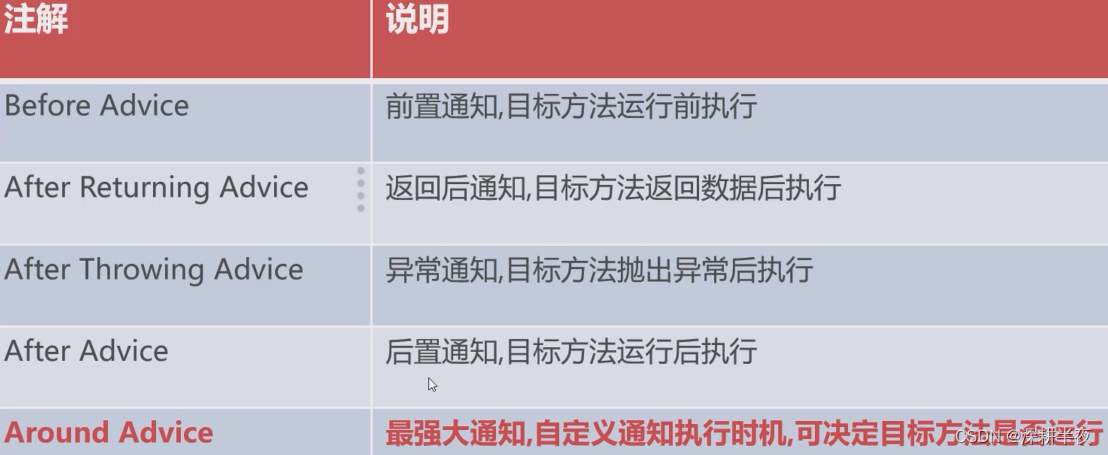文章摘要
一、AOP关键词
| 注解 | 关键词 |
|---|---|
| AspectJ | 切面:就是一个标准的类,在切面类中定义切面方法 |
| joinPoint | 连接点:切面方法里的参数,可以获取到目标类、目标方法的信息 |
| Target Class / Method | 目标类、目标方法 |
| PointCut | 切入点:使用execution表达式,指定要切入哪个目标类、哪个目标方法上 |
| Advice | 通知:确定了切入点之后,通知用来确定什么时候执行,例如:before、after… |
二、Spring AOP 的xml基本用法
//schema的设置
<?xml version="1.0" encoding="UTF-8"?>
<beans xmlns:xsi="http://www.w3.org/2001/XMLSchema-instance"
xmlns:context="http://www.springframework.org/schema/context"
xmlns:aop="http://www.springframework.org/schema/aop"
xmlns="http://www.springframework.org/schema/beans"
xsi:schemaLocation="http://www.springframework.org/schema/beans
http://www.springframework.org/schema/beans/spring-beans.xsd
http://www.springframework.org/schema/context
http://www.springframework.org/schema/context/spring-context.xsd
http://www.springframework.org/schema/aop
http://www.springframework.org/schema/aop/spring-aop.xsd">
</beans>
===========================================================================
//AOP配置
<bean id="methodAspect" class="com.imooc.spring.aop.aspect.MethodAspect"></bean>
<aop:config>
<!-- 规定切入点 -->
<aop:pointcut id="pointcut" expression="execution(* com.imooc..*Service.*(..))"></aop:pointcut>
<!-- 设置切面类 -->
<aop:aspect ref="methodAspect">
<!-- 设置通知 设置切入点 -->
<aop:before method="printExecutionTime" pointcut-ref="pointcut"/>
</aop:aspect>
</aop:config>
二、JoinPoin的核心方法
| 核心方法 | 说法 |
|---|---|
JoinPoint.getTarget() | 获取目标类 对象 |
| JoinPoint.getTarget().getClass().getName () | 获取目标 类名称 |
JoinPoint.getSignature() .getName() | 获取目标 方法名 |
JoinPoint.getArgs() | 获取目标 方法参数 |
三、PointCut 的 execution表达式

四、Advice 的五种通知类型

五、基于注解 开发Spring AOP
用注解 ===>>> 开启组件扫描:
//注解配置Bean
<context:component-scan base-package="com.test.spring.ioc.entity"></context:component-scan>
//启用Spring AOP注解模式
<aop:aspectj-autoproxy/>
1、找到 切面类 添加
@Component+@Aspect
2、找到对应的切面方法 添加
@Advice("execution(* com.imooc..*Service.*(..))")
六、Spring AOP底层的实现原理
Spring基于代理模式实现功能动态扩展,其中包含两种形式:
1、目标类拥有接口,通过JDK动态代理实现功能扩展
2、目标类没有接口,通过CGLib组件实现功能扩展
七、代理模式
//接口
public interface UserService {
public void createUser();
}
//接口实现类
public class UserServiceImpl implements UserService {
@Override
public void createUser() {
System.out.println("执行创建用户的业务逻辑");
}
}
//程序入口
public class Application {
public static void main(String[] args) {
UserService userService = new UserServiceImpl();
userService.createUser();
}
}
//运行输出: ====>>> 执行创建用户的业务逻辑
7.1、静态代理
==================添加功能:获取 createUser方法 执行的时间==================
//创建代理类:
//代理类和委托类 都要实现相同的接口
public class UserServiceProxy implements UserService{
//通过有参构造,在创建代理类时,就可以 ==> 持有委托类的对象
private UserService userService;
public UserServiceProxy(UserService userService) {
this.userService = userService;
}
public void createUser() {
System.out.println("======"+ new SimpleDateFormat("yyyy-MM-dd HH:mm:ss SSS").format(new Date())+"======");
userService.createUser();
}
}
//程序入口
public class Application {
public static void main(String[] args) {
UserService userServiceProxy = new UserServiceProxy(new UserServiceImpl());
userServiceProxy.createUser();
}
}
//运行输出: ====>>> ======2020-07-13 20:51:34 247======
// 执行创建用户的业务逻辑
7.2、动态代理
==================添加功能:获取 createUser方法 执行的时间==================
public class ProxyInvocationHandler implements InvocationHandler {
private Object target;//目标对象
public ProxyInvocationHandler(Object target) {
this.target = target;
}
/**
* @param proxy 代理类对象
* @param method 目标方法的对象
* @param args 目标方法的参数
* @return 目标方法运行后返回值
* @throws Throwable
* 该方法和反射有关。而且和Advice里的Around 非常相似。
*/
@Override
public Object invoke(Object proxy, Method method, Object[] args) throws Throwable {
System.out.println("======要添加的业务======");
//下面开启 执行目标方法
Object ret = method.invoke(target, args);
return ret;
}
public static void main(String[] args) {
UserService userService = new UserServiceImpl();
ProxyInvocationHandler proxyInvocationHandler = new ProxyInvocationHandler(userService);
//动态创建代理类
UserService userServiceProxy = (UserService) Proxy.newProxyInstance(userService.getClass().getClassLoader(),
userService.getClass().getInterfaces(),proxyInvocationHandler);
userServiceProxy.createUser();
}
}





















 7万+
7万+











 被折叠的 条评论
为什么被折叠?
被折叠的 条评论
为什么被折叠?








